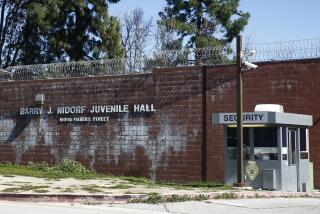Preventive Medicine for Youth Crime
- Share via
SANTA ANA — Using a federal grant of nearly $1 million, the city’s Police Department will launch a pilot mentoring and recreation program designed to fight youth crime in the west end.
As part of its effort to attack the roots of crime, the grant will also pay a USC professor to conduct extensive research on Santa Ana residents who end up behind bars. The hope is that, through careful observation of criminals inside and outside of prison, police will better understand what causes crime in this community.
The hope is that Santa Ana will create a model project that will be used to instruct police departments nationwide in creating an effective community-based policing strategy.
“Even if it fails, it succeeds because they learn what is not working to prevent crime,” said David Hartl, a USC professor of public policy.
The Police Department will select 100 eighth-graders who have failed at least two classes to participate in the yearlong program.
“Our hope is that we will change their lives,” said Mayor Miguel A. Pulido Jr.
The west end encompasses everything west of Flower Street and north of 1st Street and includes a wide range of wealth and ethnic groups.
To be successful, the program will take a massive community effort. Police are asking churches and nonprofit organizations that serve the area to supply hundreds of college-aged mentors and tutors to turn the kids back on to school.
The city’s parks and recreation department will pitch in to create after-school sports programs.
The Department of Justice will pay for the project with a $956,000 grant, which will allow the city to devote seven police officers and 13 recreation employees to the west end experiment.
Santa Ana was one of 21 cities nationwide that received similar grants to create strategies to prevent crime. The others in California are San Diego and Concord.
City officials said Tuesday that the department secured the grant because of its reputation as a national leader in the movement to attack crime through community-based policing. With this tactic, officers work with community groups to prevent crime before it happens.
Santa Ana adopted this approach nearly 25 years ago and has created several neighborhood-oriented programs to reduce gang activity and prevent murders that have been replicated across the nation and in other countries.
Pulido called the program one of the most ambitious and innovative in the department’s long history of community-based policing.
“I really believe that this program is going to take law enforcement into the 21st century,” he said.
Hope Hamashige can be reached at (714) 564-1036 or hope.hamashige@latimes.com
More to Read
Sign up for Essential California
The most important California stories and recommendations in your inbox every morning.
You may occasionally receive promotional content from the Los Angeles Times.













![Vista, California-Apri 2, 2025-Hours after undergoing dental surgery a 9-year-old girl was found unresponsive in her home, officials are investigating what caused her death. On March 18, Silvanna Moreno was placed under anesthesia for a dental surgery at Dreamtime Dentistry, a dental facility that "strive[s] to be the premier office for sedation dentistry in Vitsa, CA. (Google Maps)](https://ca-times.brightspotcdn.com/dims4/default/07a58b2/2147483647/strip/true/crop/2016x1344+29+0/resize/840x560!/quality/75/?url=https%3A%2F%2Fcalifornia-times-brightspot.s3.amazonaws.com%2F78%2Ffd%2F9bbf9b62489fa209f9c67df2e472%2Fla-me-dreamtime-dentist-01.jpg)